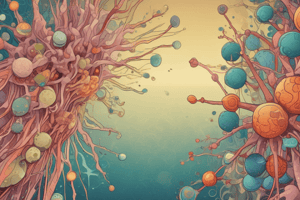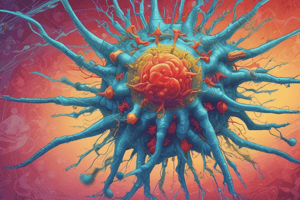Podcast
Questions and Answers
Which of the following characteristics of parvovirus B19 is most crucial in its ability to cause transient aplastic anemia in children with pre-existing hemolytic anemias?
Which of the following characteristics of parvovirus B19 is most crucial in its ability to cause transient aplastic anemia in children with pre-existing hemolytic anemias?
- The virus's preferential infection of RBC precursor erythroblasts in the bone marrow, impairing RBC production. (correct)
- The virus's ability to induce IgM/IgG immune complex formation, contributing to rash and arthritis.
- The virus's tropism for endothelial cells, leading to the characteristic rash of erythema infectiosum.
- The virus's need for host cell DNA polymerase, limiting its replication to actively dividing cells.
A pregnant woman in her second trimester is diagnosed with parvovirus B19 infection. Which of the following fetal complications is of greatest concern during this stage of gestation?
A pregnant woman in her second trimester is diagnosed with parvovirus B19 infection. Which of the following fetal complications is of greatest concern during this stage of gestation?
- Potential development of hydrops fetalis due to fetal anemia and heart failure. (correct)
- Elevated risk of preterm labor and delivery from maternal viremia.
- Increased risk of fetal death due to the virus's cytotoxic effects.
- High probability of congenital abnormalities affecting organogenesis.
Why is parvovirus B19 infection more likely to cause symptomatic arthralgia and arthritis in adult women compared to other populations?
Why is parvovirus B19 infection more likely to cause symptomatic arthralgia and arthritis in adult women compared to other populations?
- Hormonal factors in women may influence the immune response to B19, leading to increased inflammation in the joints. (correct)
- Adult women are less likely to have developed immunity to Parvovirus B19 during childhood
- Adult women are more likely to have pre-existing autoimmune conditions, exacerbating the immune response to the virus.
- The higher prevalence of occupational exposures in women increases the risk of parvovirus B19 infection and subsequent joint symptoms.
What is the primary mechanism by which parvovirus B19 achieves replication within human host cells, given its lack of viral polymerase?
What is the primary mechanism by which parvovirus B19 achieves replication within human host cells, given its lack of viral polymerase?
Which immunological finding would be most indicative of a recently acquired parvovirus B19 infection in a child presenting with a 'slapped cheek' rash and mild fever?
Which immunological finding would be most indicative of a recently acquired parvovirus B19 infection in a child presenting with a 'slapped cheek' rash and mild fever?
In a patient with sickle cell disease, what hematological consequence of parvovirus B19 infection poses the most immediate threat?
In a patient with sickle cell disease, what hematological consequence of parvovirus B19 infection poses the most immediate threat?
Why is routine vaccination against parvovirus B19 not currently recommended, despite the potential severity of complications in certain populations?
Why is routine vaccination against parvovirus B19 not currently recommended, despite the potential severity of complications in certain populations?
An immunocompromised patient develops chronic parvovirus B19 infection. How does the treatment with intravenous immunoglobulin (IVIG) work to combat the infection?
An immunocompromised patient develops chronic parvovirus B19 infection. How does the treatment with intravenous immunoglobulin (IVIG) work to combat the infection?
What feature of the parvovirus B19 capsid is most relevant to the design of potential therapeutic interventions targeting viral entry?
What feature of the parvovirus B19 capsid is most relevant to the design of potential therapeutic interventions targeting viral entry?
During which season is erythema infectiosum most commonly diagnosed, and how does this seasonality relate to the virus's transmission dynamics?
During which season is erythema infectiosum most commonly diagnosed, and how does this seasonality relate to the virus's transmission dynamics?
Flashcards
Parvovirus B19
Parvovirus B19
A nonenveloped single stranded DNA virus that causes Fifth Disease.
Slapped Cheek Rash
Slapped Cheek Rash
Bright red rash on cheeks seen in children with Fifth Disease caused by Parvovirus B19.
Respiratory Droplets
Respiratory Droplets
Fifth disease, caused by parvovirus B19, is commonly transmitted via this route.
Aplastic Anemia (Parvovirus B19)
Aplastic Anemia (Parvovirus B19)
Signup and view all the flashcards
Hydrops Fetalis (Parvovirus B19)
Hydrops Fetalis (Parvovirus B19)
Signup and view all the flashcards
Arthralgia (Parvovirus B19)
Arthralgia (Parvovirus B19)
Signup and view all the flashcards
IgM Antibodies (Parvovirus B19)
IgM Antibodies (Parvovirus B19)
Signup and view all the flashcards
IVIG (Parvovirus B19)
IVIG (Parvovirus B19)
Signup and view all the flashcards
Study Notes
- Fifth Disease, also known as slapped cheek syndrome or erythema infectiosum, is caused by parvovirus B19.
- Parvovirus B19 is a nonenveloped, single-stranded, negative-sense DNA virus.
- Parvovirus B19 can lead to spontaneous miscarriages.
- The virus can trigger sickle cell crises in susceptible individuals.
- Individuals with chronic anemia, thalassemia, and spherocytosis are at risk of transient but severe aplastic anemia from B19 infection.
- Parvovirus B19 requires host cell DNA polymerase machinery for replication and transcription within the nucleus as it lacks its own viral polymerase.
- The parvovirus capsid is icosahedral (20-sided symmetry) and is the smallest nonenveloped virus at 22nm and there is only one serotype.
- Transmission occurs primarily through respiratory droplets.
- This virus can also spread through blood transfusions and transplacental transmission.
- First trimester infections can result in fetal death.
- Second trimester infection is associated with hydrops fetalis (fluid accumulation in the fetus).
- Infections contracted during the third trimester typically do not lead to major complications.
- Parvovirus B19 is not considered a common cause of congenital abnormalities.
- By age 18, approximately 50% of individuals in the U.S. have antibodies against parvovirus B19.
- Erythema infectiosum is most commonly observed in children aged 4-15 years.
- Adults may experience arthralgia (joint pain) or arthritis (bilateral involvement of small joints in hands and feet), particularly in females.
- Parvovirus B19 primarily infects RBC precursor erythroblasts in the bone marrow, potentially leading to aplastic anemia.
- It also targets endothelial cells, contributing to the rash seen in erythema infectiosum.
- IgM/IgG immune complexes play a role in rash and arthritis development in adults.
- Fifth disease is generally mild, especially in children.
- A characteristic bright red rash appears on the cheeks ("slapped cheeks"), accompanied by a less intense, "lacy" erythematous rash on the body.
- Differentiation from other maculopapular rash-causing conditions like measles, rubella, scarlet fever, and roseola may be difficult.
- Common symptoms include low-grade fever, runny nose, and sore throat.
- Symptoms typically subside within about a week.
- Diagnosis relies on symptoms (such as the slapped cheek rash) and the presence of IgM antibodies for Fifth disease and aplastic anemia.
- PCR can detect viral DNA in the blood of immunocompromised patients.
- There is no specific treatment or vaccine available, but immunoglobulins (IVIG) might be helpful for chronic infections in immunocompromised individuals.
- Infections are most prevalent in late winter and spring.
- Parvovirus B19 infection occurs worldwide.
- Infection confers lifelong immunity.
Studying That Suits You
Use AI to generate personalized quizzes and flashcards to suit your learning preferences.




